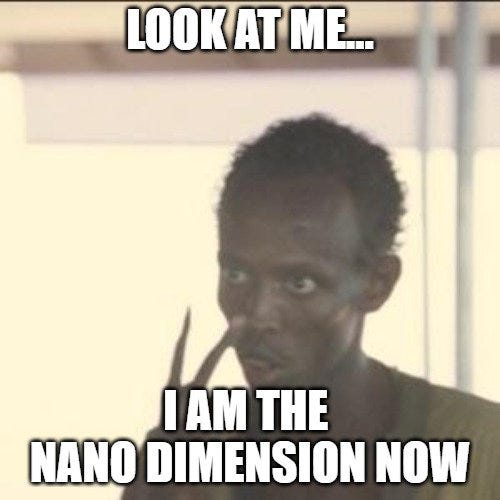Atomic Layer of the Day:
It looks like no one wanted to do this on April Fools' Day. Though in one case, you probably know my opinion?
Today, Hexagon completed the acquisition of 3D Systems' Geomagic portfolio, and Nano Dimension officially completed the acquisition of Desktop Metal.
Regarding the first transaction, everything here is quite clear. Hexagon announced the completion of the Geomagic acquisition from 3D Systems. The deal was first announced in December last year and was valued at $123 million. 3D Systems acquired Geomagic in 2013, and it was one of the few companies taken over during that crazy time that not only wasn’t wasted but actually developed significantly.
Geomagic's portfolio includes tools for measurement, quality control, mesh and surface modeling, and parametric scanning to CAD (reverse engineering). It will now be integrated into Hexagon’s Manufacturing Intelligence division. The company assures that it will continue supporting existing Geomagic customers, enhancing functionalities, especially for portable metrology device users.
Geomagic’s flagship products include Design X—an advanced 3D scanning and part digitization tool, and Control X—a 3D inspection solution with compliance validation for NIST, PBT, and NPL standards, which will now be enriched with Hexagon’s geometric tolerance libraries.
Hexagon has also announced further investments in these solutions, integrating them into its metrology platform.
As for the second transaction, it marks the end of a nine-month-long saga, which had to be settled by a court ruling.
A week ago, Nano Dimension was forced by court order to acquire Desktop Metal, and today, it became a reality.
I've covered this topic multiple times, most recently in my LinkedIn newsletter – 3DP War Journal:
The deal was finalized at $179.3 million, translating to $5.295 per share. In its press release, Nano Dimension projects consolidated revenues for 2024 to exceed $200 million.
At the same time, Nano Dimension's new management, which took over in December 2024, has initiated a comprehensive transformation of the company. The main goals of this strategy include: achieving profitability through cost reductions, improving production efficiency and optimizing supply chains.
So basically, what I wrote about in yesterday’s article is coming true:
Nano Dimension plans to unveil a detailed integration strategy for both companies soon. The company also announced that in future communications, it will discuss potential synergies related to the planned merger with Markforged. (So, it’s happening after all.)
I'm curious to see how this will unfold… And how many of the businesses acquired by these companies will actually survive?
Atomic Layer from the Past:
04-02-2019: Formlabs introduced the Form 3 and Form 3L 3D printers.
‘2013 in AM’ - brand new history book! GET IT NOW!
News & Gossip:
Bambu Lab has released BambuStudio 2.0, introducing significant improvements for its 3D printing software. The update focuses on workflow enhancements, including clearer nozzle/printer selection and better handling of dual-extrusion systems like the new H2D printer. New filament-saving modes optimize multi-material printing, reducing waste. AMS spool synchronization and preset management have also been refined. The update addresses long-standing usability issues while supporting advanced configurations.
Ricoh UK has divided into two companies: ETRIA (a Ricoh-Toshiba joint venture) handling toner/office printers, and Ricoh Printing Solutions Europe (RPSE) managing additive manufacturing and industrial inkjet solutions. The restructuring brings no major operational changes but increases agility while remaining part of the Ricoh Group.
The WonderMaker ZR Ultra, which I’ve mentioned multiple times, has launched on Kickstarter and has already reached nearly $400,000 in funding—far exceeding the initial goal of $51,400. The company has prepared a wide range of purchasing options, so if you want to learn them, you’ll have to go through it yourself on the campaign page. WonderMaker has also released several videos, and… I don’t know, but it doesn’t look as impressive as in the original announcements. I watched the video below twice, and to me, it looks like a very budget version of the Prusa XL. Honestly, if I really wanted a 3D printer with this functionality, I’d still buy it from the Czech guy. That’s just how I feel for now.








